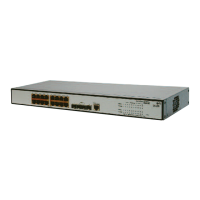1-30
Parameters
mode1: Sets the MAC address format to XXXX-XXXX-XXXX, where each X represents a hexadecimal
number.
mode2: Sets the MAC address format to XX-XX-XX-XX-XX-XX.
lowercase: Uses lowercase letters in the MAC address.
uppercase: Uses uppercase letters in the MAC address.
Description
Use the calling-station-id mode command to configure the MAC address format of the
Calling-Station-Id (Type 31) field in RADIUS packets.
Use the undo calling-station-id mode command to restore the default format.
By default, the MAC address format is XXXX-XXXX-XXXX, in lowercase.
Examples
# Set the MAC address format of the Calling-Station-Id field to XX-XX-XX-XX-XX-XX, in uppercase.
<Sysname> system-view
System View: return to User View with Ctrl+Z.
[Sysname]radius scheme system
[Sysname-radius-system]calling-station-id mode mode2 uppercase
data-flow-format
Syntax
data-flow-format data { byte | giga-byte | kilo-byte | mega-byte } packet { giga-packet |
kilo-packet | mega-packet | one-packet }
undo data-flow-format
View
RADIUS scheme view
Parameters
data: Sets the data unit of outgoing RADIUS flows, which can be byte, giga-byte, kilo-byte, or
mega-byte.
packet: Sets the packet unit of outgoing RADIUS flows, which can be one-packet, giga-packet,
kilo-packet, or mega-packet.
Description
Use the data-flow-format command to set the units of RADIUS data flows to RADIUS servers.
Use the undo data-flow-format command to restore the default units.
By default, the data unit and packet unit of outgoing RADIUS flows are byte and one-packet
respectively.

